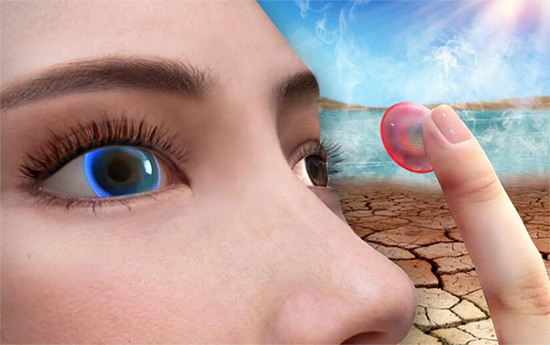Contact lenses that monitor eye health have emerged over the last several years. Current designs involve sensors embedded in a soft contact lens that connect with an external wireless device. Last year, researchers at the Shenzhen Institutes of Advanced Technology (SIAT) of the Chinese Academy of Sciences found a different approach to “smart” contact lenses. They developed a contact lens that can show real-time changes in eye surface moisture and intraocular pressure by changing colors.
 |
Credit: DU Xuemin
The lenses are made of pHEMA hydrogel, a material researchers emphasize is identical in structure to an FDA approved contact lens material already in use worldwide, but the color change occurs without any chemical pigments. Researchers refer to the lenses as “structurally colored.” Reflective properties of nanostructures, which are of intermediate size between microscopic and molecular structures, are within the hydrogel matrix and produce color changes from red to green to blue. The color variation is in response to differences in the reflectance wavelengths caused by changes in eye surface conditions. Under normal conditions, the lenses do not change from their normal red color, but with xerophthalmia, a condition in which the eye fails to produce tears, the lenses turn blue. Increased intraocular pressure will also change the reflective properties of the lenses, turning them blue as well.The lenses currently are designed as a diagnostic tool for point-of-care (POC), rather than for constant wear, with color change occurring in about 25 minutes under test conditions. Early diagnosis and treatment of eye disease is key to preserving sight, but present diagnostic testing for elevated intraocular pressure and xerophthalmia can involve the use of instruments and complex procedures. Researchers hope the lenses will provide easier, instrument-free testing for those conditions, resulting in greater patient comfort. They anticipate that, “structurally colored materials, … will contribute to desirable progress in the field of diagnostics.” What’s more, Prof. DU Xuemin, leader of the research group, believes, “It will also inspire the design of a new generation of wearable devices with colorimetric sensing capabilities for real-time POC monitoring of various human body signs and diseases."
The possibilities for contact lens use beyond vision are expanding rapidly. You can learn more about the future of contact lenses for information and medical monitoring with our CE, Therapeutic Contact Lenses and Beyond, at 2020mag.com/ce.













